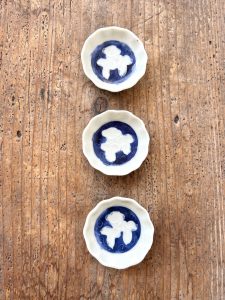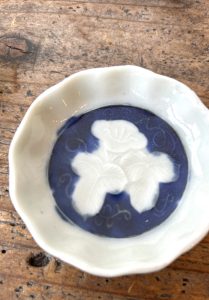心を躍らせる豆皿たち(愛知県名古屋市千種区姫池通 骨董買取 古美術風光舎)
2023.11.05
皆さまこんにちは。スタッフHでございます。
先日、食器棚で眠っていた豆皿に残り物を乗せて出してみたら、食卓が華やかになり、なぜかお腹も満たされました。視覚を満足させると、満腹感も得ることができるとか。不思議です。
豆皿のサイズの定義は曖昧なようですが、大体9~10センチまでの手のひらサイズのものを指すようです。小さいながらもユニークな形や緻密な絵付け、様々な趣向を凝らしたものが多く自由度の高いうつわです。値段も手ごろでバリエーションも豊かなので、コレクターの方も多いとか。かくいう私もミニチュアが大好きで、豆皿などは衝動買いをしないよう心にブレーキをかけております。
風光舎にも愛らしい豆皿がいくつかございます。こちらは瀬戸焼で真ん中に朝顔が描かれています。艶があってとても魅力的です。


豆皿の起源は江戸時代に生まれた「手塩皿」だとされています。1600年代に中国王朝が明から清へと変わり、中国の窯業が打撃を受けた頃、日本の有田は世界の磁器生産の中心に発展しました。国内向けにも日本の食生活にあった食器を作るようになり、これまでになかった日本独自の食器が生まれます。その一つが手塩皿でした。
手塩皿に塩を盛って食膳の箸の脇に置いていました。元々は「食膳の不浄を祓うため」だったそうです。次第にその塩を使って自分好みの味付けをするようになりました。味加減を自分で調え、人任せにせず自らの手をかけて面倒をみることから「手塩にかける」という表現が生まれたと言われています。
相撲の力士が土俵を塩で清めるように、日本では昔から塩には清める力があると信じられてきました。
神道においてのお祓いの起源は「古事記」などの神話に見ることが出来ます。イザナギノミコトが妻であるイザナミノミコトがいる黄泉の国から戻った後、自分の体についた死の国の穢れ(けがれ)を祓うため海水につかって禊(みそぎ)を行ったというくだりがあります。黄泉がえりの儀式に海水が使われたことを起源として生まれたのが神道における「塩で清める」という行為だといわれています。
しかし穢れとは決して死者を不浄なものとして忌避する言葉ではなく、穢れは「気枯れ」とも書き、生命力が枯渇してしまった状態を表すそうです。この状態からもとの平穏な日常に戻るために使われるのが、あらゆる生命の源である海水から作られた塩であり、塩には清める力と共に再生させる力が宿っているとも考えらています。
そんな「清め塩」を盛るという用途から生まれた豆皿ですが、現在ではお菓子やアクセサリーなど様々なものを乗せたり、壁に飾ってみたり、多種多様な使い方がされているようです。
「ちいさきもの」が好きな日本人の気質に豆皿はぴったり合っているのでしょうね。
それでは、またお会いしましょう。

Hello everyone. This is Staff H.
The other day, I served leftovers on a bean dish that had been sitting in the cupboard, and it made the table more colorful and somehow filled my stomach. I hear that when you satisfy your visual sense, you also get a feeling of fullness.
The definition of the size of a mame-plate seems to be ambiguous, but it seems to be roughly the size of the palm of your hand, up to 9 to 10 centimeters. Despite their small size, these dishes have unique shapes, intricate painting, and a variety of elaborate designs, giving them a high degree of freedom. They are also reasonably priced and come in a wide variety of styles, making them popular among collectors. I love miniatures myself, and I try not to buy miniature dishes on impulse.
Fukosha also has some adorable miniature plates. This one is Seto ware with a morning glory in the center. It is shiny and very attractive.
It is said that the origin of mame-dara (bean dish) is Teshio-sara, which originated in the Edo period (1603-1868), when the Chinese dynasty changed from Ming to Qing in the 1600s and the Chinese ceramic industry was hit hard, Arita in Japan developed into the center of porcelain production in the world. The Japanese began to produce tableware for the domestic market that suited the Japanese diet, giving birth to unique Japanese tableware that had never existed before. Typical examples of this were salt dishes and long dishes.
These dishes were originally used to purify the food by serving salt and placing it beside the chopsticks on the dining table. Gradually, people began to use them to season their food to their own taste. It is said that the phrase “teshio ni kakeru” was born from the fact that people would adjust the seasoning by themselves and take care of the food with their own hands, rather than leaving it to others.
In Japan, it has long been believed that salt has the power to purify the body, just as sumo wrestlers purify the ring with salt.
The origin of Shinto purification can be found in myths such as the Kojiki. In this myth, Izanagi no Mikoto purified himself by bathing in seawater after returning from the land of Hades, where his wife Izanami no Mikoto lived, in order to purify his body of the impurities of the land of death. It is said that the act of purification with salt in Shinto originated from the use of seawater in the ritual of Yomigaeri.
The word “defile,” however, is not a word to avoid the dead as unclean, but is written “ki-kare,” which means “to wither,” and is said to describe the state of being drained of life force. Salt made from seawater, the source of all life, is used to return from this state to a normal, peaceful life, and salt is believed to have the power to both purify and regenerate.
It is believed that salt has the power to purify as well as to regenerate. Mame-dara (small plates) were born to serve salt for purification, but today they are used in a wide variety of ways, such as to display sweets, accessories, and other items, or to decorate walls.
Mame-dara (miniature dishes) are probably a perfect match for the Japanese people’s love of “small things.
See you again soon.
*******************
ご実家の整理やお片付けなどをされている方のご相談などが多くございます。
お片付けなどくれぐれもご無理のないようになさってくださいませ。
風光舎では古美術品や骨董品の他にも絵画や宝石、趣味のお品など様々なジャンルのものを買受しております。
お片付けをされていて、こういうものでもいいのかしらと迷われているものでも、どうぞお気軽にご相談下さいませ。
また風光舎は、出張買取も強化しております。ご近所はもちろん、愛知県内、岐阜県、三重県その他の県へも出張いたします。
まずは、お電話お待ちしております。
***************************************
愛知県名古屋市千種区姫池通
骨董 買取【古美術 風光舎 名古屋店】
TEL052(734)8444
10:00-17:00 OPEN
#出張買取#骨董#古美術#骨董品#絵画#版画#茶道具#刀剣#彫刻

